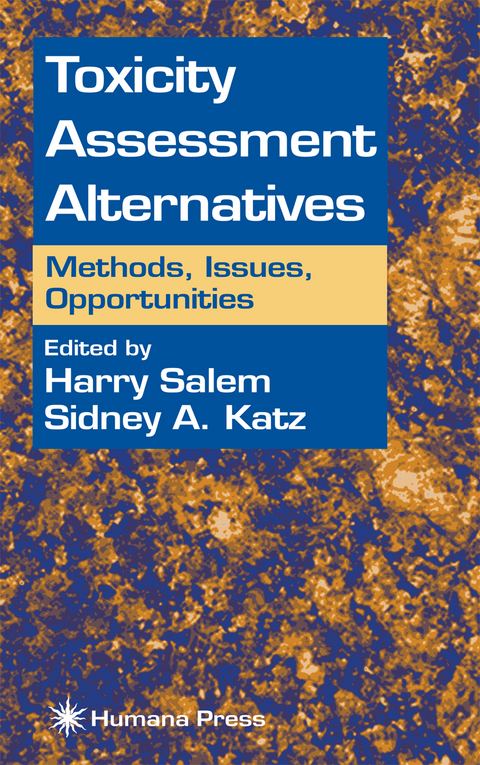
Toxicity Assessment Alternatives
Humana Press Inc. (Verlag)
978-0-89603-787-8 (ISBN)
Toxicity Assessment Alternatives: Methods, Issues, Opportunities contains a broad array of critical surveys, contributed by active and respected investigators, describing their research and offering updates on toxicity assessment alternatives, directions determined by current and future grant programs, opportunities for mechanistically based test methods to detect endocrine disruptor activity, the use of alternatives in the Department of Defense hazard assessment initiatives, and the issues and opportunities for validation and regulatory acceptance. Several of these advances make use oftransgenic models that reduce the time and cost of carcinogenicity testing. Others use tissue cultures for the assessment of endocrine disrupting chemicals. Cultures of human epidermal keratinocytes are applicable as models for sulfur mustard lesions, and in vitro protein denaturation is used as a chemical test for assessing the ocular and dermal irritation potential of cosmetic prod ucts. Molecular modeling is applied to explaining chemical toxicity. Commercially developed assay systems have undergone extensive evaluation by their manufacturers. Some of these await external valida tion, and others await acceptance by North American and European regulatory agencies. Toxicity Assessment Alternatives: Methods, Issues, Opportunities provides information from members of the scientific and regulatory communities on what has been achieved and what has been accepted in alternatives to animal testing.
I. Recent Developments on Alternatives.- 1 Tissue Engineering: An Important Technology for Assessment of Toxicity.- 2 Tissue Engineering: Technology Applications and FDA Initiatives.- 3 Electrical Resistance Method for Measuring Volume Changes in Astrocytes.- 4 Cytotoxicity Profiles for a Series of Investigational Compounds Using Liver Slice Technology and Human-Derived Cell Cultures.- 5 Antagonistic Interaction of Sodium Arsenite and Lead Sulfate with UV Light on Sister Chromatid Exchanges in Human Peripheral Lymphocytes.- 6 The Role of Upper Airway Heat and Water Vapor Exchange in Hygroscopic Aerosol Deposition in the Human Airway: A Deposition Model.- 7 Moving Average Interpolation for Malathion LC50 Estimation on Dugesia tigrina: Comparison with Probit and “One-Point” Methods.- 8 Physiological Modeling of Benzo(a)pyrene Pharmacokinetics in the Rat.- II. Current Trends and Future Directions.- 9 Resources for Biomedical Research: Opportunities for Alternatives.- III. Mechanistically Based Test Methods as Alternatives.- 10 Endocrine Disruption in Wildlife: Scientific Processes and Principles for Evaluating Effects.- 11 Mechanistic Animal-Replacement Approaches for Predicting Pharmacokinetics of Organic Chemicals.- IV. Use of Alternatives in Hazard Assessment Initiatives.- 12 Validation of the CytosensorTM Microphysiometer for In Vitro Cytotoxicity Testing.- 13 Sulfur Mustard Effects on Cell Yield Alter Viability Assessment in Normal Human Epidermal Keratinocytes.- 14 Development of Human Keratinocyte Colonies for Confocal Microscopy and for Study of Calcium Effects on Growth Differentiation and Sulfur Mustard Lesions: A Model.- 15 Phosgene-Induced Calcium Changes in Pulmonary Artery Endothelial Cells.- 16 Enhanced Proteolytic Activity and Fc Receptor Expression inHuman Epithelial Cells Following Exposure to Sulfur Mustard.- 17 Altered Expression of lntracellular and Surface Antigens by Cultured Human Epidermal Keratinocytes Exposed to Sulfur Mustard.- 18 Effect of Sulfur Mustard Exposure on Human Epidermal Keratinocyte Viability and Protein Content.- 19 The Use of In Vitro Systems to Define Therapeutic Approaches to Cutaneous Injury by Sulfur Mustard.- 20 Effects of Poly (ADP-Ribose) Polymerase Inhibitors on the Sulfur Mustard-Induced Disruption of the Higher-Order Nuclear Structure of Human Lymphocytes.- 21 DNA Repair Enzymatic Response in Cultured Human Epidermal Keratinocytes Following Sulfur Mustard Exposure.- 22 Human Hepatocytes: A Novel Animal Alternative.- V. Validation, Regulatory Acceptance, and Animal Protection Perspectives.- 23 An Animal Protection Perspective.- 24 Federal Interagency Activities Toward Validation and Regulatory Acceptance of Alternative Tests.
| Zusatzinfo | 24 Illustrations, black and white; XIII, 262 p. 24 illus. |
|---|---|
| Verlagsort | Totowa, NJ |
| Sprache | englisch |
| Maße | 148 x 221 mm |
| Themenwelt | Medizin / Pharmazie ► Medizinische Fachgebiete ► Pharmakologie / Pharmakotherapie |
| Medizin / Pharmazie ► Pharmazie | |
| Studium ► 2. Studienabschnitt (Klinik) ► Pharmakologie / Toxikologie | |
| Naturwissenschaften ► Biologie ► Biochemie | |
| ISBN-10 | 0-89603-787-8 / 0896037878 |
| ISBN-13 | 978-0-89603-787-8 / 9780896037878 |
| Zustand | Neuware |
| Haben Sie eine Frage zum Produkt? |
aus dem Bereich


